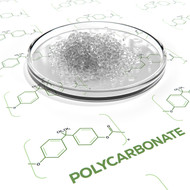PC: Engineering Polymer for High Performance
History
Polycarbonates were discovered by German scientist Alfred Einhorn in the late 1890s. However, despite more than 30 years of research into this class of polymers, the project was abandoned, as it had not yielded commercial products. After nearly 50 years with no significant advances reported, research resumed. H. Schnell at Bayer patented the first linear polycarbonate and D. Fox at General Electric filed for a similar patent for a branched polycarbonate. By the 1960s, both companies were commercializing polycarbonate under the trade names of Makrolon (Bayer, 1958) and Lexan (GE Plastics, 1960). Within the next decade, the original brownish color of polycarbonate was improved to the clear material known today.
Polycarbonate (PC) is a polymer belonging to the class of thermoplastics, synthesized from the bisphenol A (BPA) monomers linked via carbonate groups (–OCOO–). There are two primary methods for its production: either through a synthetic route involving phosgene or via a transesterification reaction with diphenyl carbonate. Like many polymers, it is petroleum-based, as it relies on the petrochemical industry for the production of BPA and phosgene. However, significant efforts have been made to develop more environmentally friendly production processes, such as carbon dioxide-based production routes that avoid phosgene, plant-based BPA alternatives, non-toxic catalytic processes that minimize waste, and novel recycling methods.
Quick Highlights
- Polycarbonate (PC) was first discovered in the late 1890s but reached the market nearly 70 years later under trade names such as Makrolon and Lexan.
- PC is a thermoplastic polymer synthesized predominantly from petroleum-derived bisphenol A (BPA) and phosgene, both of which are categorized as hazardous chemicals.
Properties
As with other types of thermoplastics, the individual characteristics of polycarbonate can be fine-tuned through the production processes and the use of additives and copolymers. Additives such as reinforcement fillers for increased strength, plasticizers for improved flexibility, UV stabilizers, or flame retardants can be incorporated to enhance specific properties. Colorants are also added for aesthetic purposes. Blending PC with polyester increases chemical resistance, while blending PC with acrylonitrile butadiene styrene (ABS) can enhance impact resistance and processability.
In terms of processing, injection molding, extrusion, and blow molding yield materials of different characteristics. Injection molding can produce stronger, more precise parts, while extrusion can form continuous profiles like sheets or rods. Crystallinity, optical clarity, and mechanical strength are also fine-tuned through the temperature and cooling rate. For example, slower cooling can improve mechanical strength, whereas a faster cooling process can enhance transparency.
Quick Highlights
- The characteristics of polycarbonate can be fine-tuned through production processes (e.g., injection molding, blow molding, or extrusion). Its crystallinity, optical clarity, and mechanical strength are adjustable by controlling the temperature and cooling rate.
- Additives, fillers, and copolymer blends can also be used to enhance specific properties.
Tensile Strength
Polycarbonate is a very strong and durable material, demonstrating excellent impact resistance (about 200 times more resistant than glass), making it ideal for applications such as bulletproof glass and protective gear like helmets. However, polycarbonate is prone to scratching. As such, a coating is typically required to improve its scratch resistance and enable PC to be used in applications such as eyewear, protective shields, and automotive parts. Another attractive feature is its low density (nearly 50% lighter than glass), making it a lightweight choice for construction and automotive applications where ease of installation and handling is important.
Quick Highlights
- Polycarbonate is a strong, durable, and lightweight material with an impact resistance 200 times greater than glass.
- It is prone to scratching, so coatings are often required to improve scratch resistance.

Thermal Stability
Polycarbonate demonstrates good thermal stability within the range of –40 to 120 °C (–40 to 248 °F), better than acrylic, retaining its shape and strength in high-heat environments. It has a high glass transition temperature of 147 °C (297 °F), meaning that the material softens gradually above this point and begins to flow at a temperature of approximately 155 °C (311 °F). Unlike acrylic, polycarbonate is more easily processed, as certain techniques allow it to be processed without heating. While acrylic is brittle and cannot be bent or shaped at room temperature, polycarbonate can undergo deformation without cracking or breaking, making it a useful alternative for applications where sheet metals are unsuitable. Its excellent dimensional stability translates to the material being able to resist mechanical stress and temperature changes without warping or deforming.
Quick Highlights
- Polycarbonate exhibits good thermal stability, being ideal for high-heat applications.
- It is easily processed, as it can be shaped and deformed at room temperature without cracking or breaking.
Transparency
Polycarbonate resembles glass in transparency, allowing up to 90% of visible light to pass through, thus enabling its use in applications such as windows, eyewear lenses, and optical discs where optical clarity is essential. However, it has low UV resistance, with prolonged exposure to UV radiation leading to degradation and discoloration. The use of UV stabilizers or coatings has greatly improved its UV resistance for outdoor applications. Finally, polycarbonate may become brittle after extended exposure to ionizing radiation above 25 kJ/kg.
Quick Highlights
- Polycarbonate’s high transparency of up to 90% makes it suitable for applications where optical clarity is critical (e.g., windows, eyewear lenses, optical discs).
- It exhibits low UV resistance, with prolonged exposure causing degradation and discoloration; this disadvantage is mitigated by the use of UV stabilizers or coatings.
Chemical Resistance
Polycarbonate exhibits moderate chemical resistance to mild acids, alcohols, and oils. However, it is susceptible to degradation and cracking when exposed to strong acids, alkalis, and organic solvents such as acetone and benzene Additionally, it has low moisture absorption, allowing it to retain its mechanical properties even in humid or wet conditions. Polycarbonate is also a good electrical insulator, naturally flame-retardant, and self-extinguishing, characteristics that make it an ideal material for applications in electronics, appliances, and automotive parts.
Quick Highlights
- Polycarbonate has moderate chemical resistance to mild acids, alcohols, and oils; it is susceptible to degradation by strong acids, alkalis, acetone, and benzene.
- It has low moisture absorption, excellent electrical insulation properties, and is naturally flame-retardant and self-extinguishing.
Sustainability
While polycarbonate is an excellent material used in various applications, its environmental impact is also significant. Studies have shown that polycarbonate can hydrolyze to bisphenol A (BPA) under conditions of high humidity and temperatures exceeding 70 °C, a process that may also occur in landfills at environmental temperatures and pH levels. Additionally, under anaerobic conditions, BPA has been shown to persist, indicating that the compound may remain in landfills and eventually reach the aquatic environment, leading to pollution. Importantly, BPA is currently listed as a potentially hazardous chemical by many countries, underscoring the need for caution when disposing of polycarbonate.
As a result, waste and energy consumption management alone are insufficient to mitigate the environmental impact. Alternatives to BPA, sustainable production processes, and effective recycling methods are essential in making polycarbonate more eco-friendly.
Quick Highlights
- Polycarbonate has a significant environmental impact, particularly because degradation in landfills can lead to the release of bisphenol A into the environment, a compound listed as a potentially hazardous chemical by many countries.
- BPA alternatives, sustainable production processes, and effective recycling methods are crucial for making polycarbonate more eco-friendly.
Note
While Acrylic and polycarbonate (PC) are similar materials and can often be used interchangeably, several factors may influence one’s choice according to the specific needs of the application. Acrylic is more economical and is better suited for applications where tensile and flexural strength, UV resistance, and transparency are prioritized. On the other hand, PC presents an improved impact strength, as well as better chemical and heat resistance.
Discover our range of Acrylic / Polycarbonate Bolts, Nuts, Washers, and Screws designed for strength, durability, and optical clarity. With a high impact resistance and lightweight properties, these products are ideal for various applications where reliability and transparency are key. The acrylic material offers excellent resistance to moisture and chemicals, making it a versatile choice for your projects.
Elevate your projects with our Nylon PA 66 / 50% Glass Fibre Reinforced Pan Cross Head Bolts. Designed for superior strength and thermal resistance, these bolts are ideal for load-bearing applications in automotive, industrial, and consumer goods industries. With enhanced mechanical properties and a high heat deflection temperature, our glass fiber reinforced material ensures reliable performance even under demanding conditions.
Browse our range of durable acrylic brackets, including clear, black, and white options. Choose from corner, right angle, and wall shelf brackets — all precision cut from polished acrylic with included M5 bolts, perfect for shelving, displays, and custom projects.





